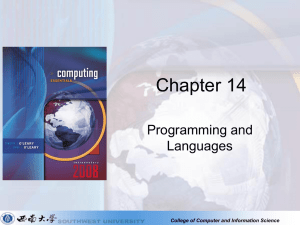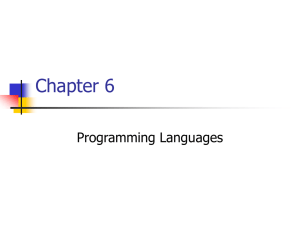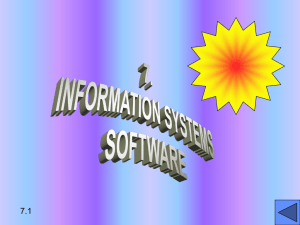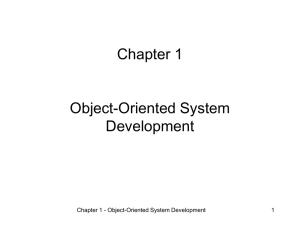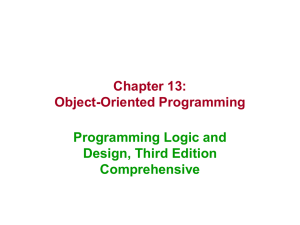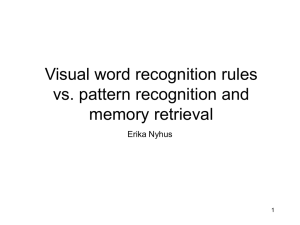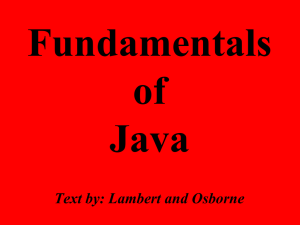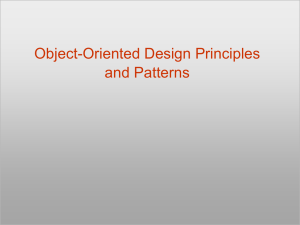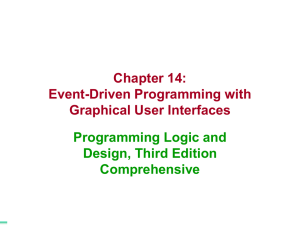Class - Shawlands Academy
advertisement
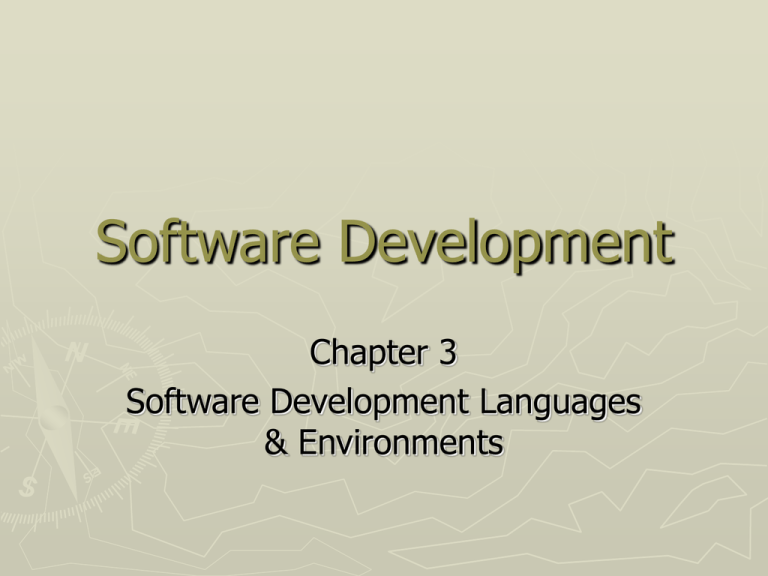
Software Development Chapter 3 Software Development Languages & Environments Content statement Higher Advanced Higher Description and comparison of procedural, declarative and event-driven languages. Description of object-oriented language. Comparison of object-oriented with procedural, declarative, event-driven and low level languages. Explanation of the trends in language development (low level to high level, 4th generation). Description of the use of module libraries. Description of the use and advantages of Computer-Aided Software Engineering (CASE) tools Background ► ► ► ► ► The fist object oriented language was called Simula 67 It was developed in the 1960’s by the Norwegian Computing Centre Simula 67 contained most of the important concepts and techniques used in present day object-oriented languages Research then progressed and led to languages like C++, Visual Basic and many others The popularity of such languages was enhanced by the increasing use of GUI’s and windows applications Conventional Programming Conventional methods of programming used imperative languages, where programs were written in terms of procedures ► Programs were sequential, running to completion branching and loping according to the programs instructions ► A flaw in this type of program was that large programs became complex and unmanageable ► Also global variables could be accessed and changed during execution so results might no be valid ► Modern Programming Today programming is done in and for a windows environment ► Windows is an event driven environment and user interaction is required to represent the programming ► Procedural languages do not possess the necessary constructs to deal with this style of programming and are unsuitable for windows applications ► Object-oriented programming techniques overcome these difficulties and make it easier for the programmer to implement good programming practices ► Object-Oriented Programming ► ► ► ► ► This is a programming methodology It compels the programmer to think in a different way about software and its development OO programming enables the creation of software that can be more readily understood and shared OO programming directly models the program and is centred around objects and data associated with them The OO language model makes use of: Objects Classes Inheritance Encapsulation Polymorphism Objects An object is a logical unit that contains both data and the code that manipulates it ► The 2 are regarded as a single unit ► Objects steams from techniques with attempting to solve reallife events employing everyday objects ► Objects share 2 characteristics, they have: A state (data) A behaviour (operations) ► Object State Behaviour Dog Size, name, colour, breed Barking, playing, sniffing, hunting Car Make, model, colour, engine size Accelerating, braking, reversing, gear changing Desk Characteristics ► A desk You know where it is, it has a certain size and colour If we move the desk we change the location property, if we paint it we change the colour property When we change the attributes of a desk we don’t change the fact that it is still a desk Object Characteristics Windows objects contain 2 parts: Attributes (data) Operations (methods) ► Here is a schematic view of an object ► Objects communicate with one another using messages Classes ► ► ► ► ► Objects of the same kind share many characteristics A car is just one of many cars A Blueprint can be produced to accommodate objects, such a blueprint is called a Class Using OO terminology a car object is an Instance of the class of objects known as cars A main class or Super-class can have Sub-classes where all sub-classes have common features based on the super-class The art of OO programming is determining the best way to divide a program into classes speeding up the development time and producing fewer lines of code meaning less errors and lower maintenance costs Car Example Suppose there exits a class called Car that contains instances of types of cars, such as four-wheel drive, saloon ► The class car would become a super-class and the various types of car become sub-class ► Libraries OO Languages depend greatly on the concept of Class Libraries ► These are sets of classes that can be used by developers as common building blocks for complex applications ► This is like the idea of module libraries used in procedural programming ► Inheritance ► ► ► ► ► ► Objects of the same kind share many characteristics and belong to a specific class It is possible to redefine a new type of object from an existing class by adding additional features without modifying the original class This opens up the possibility of reusing existing code and is known as Inheritance Reuse of code is one of the most important features of OO languages OO Programs are easier to modify If an error is found and fixed in the super-class it is automatically fixed in all derived classes Desk Example If we create a class called Furniture and describe it then the desk can be made a member of this class ► We can also add another class called table ► Both desk and table will inherit all the attributes and operations of the class furniture with additional features ► Encapsulation ► ► ► ► ► ► Objects contain data together with operations that can be applied to data In OO Programming objects interact with each other by the use of Messages The only aspect that an object knows about another object is the object’s Interface Good design means that no direct access is allowed to an objects data or the content of an object’s methods You can use an objects methods but not interfere with them, meaning that an object can not change the internal state of other objects. This is called Encapsulation c Polymorphism Two or more classes derived from a super-class are said to be polymorphic ► Polymorphisms allows 2 or more classes to respond to the same message in different ways ► Super-class Sub-classes Each sub-class responds to the draw message in a different way by drawing different shapes Pupil task A national chain of fitness clubs is having a new program created to process members‘ details. The most common object in the program will be a member's record. (a) Describe how an object-oriented language would use objects and methods to implement such a program. (b) Describe one operation that might be performed on the member object. (c) It is suggested that an object-oriented language might ensure a shorter implementation stage and easier maintenance than a procedural language. Explain why an object-oriented language might ensure a shorter implementation stage. Answers (a) The member would be an object with the attached data items (encapsulated) such as membercode, forename, etc (1). Functions known as methods would allow the data items of the code to be manipulated (1). b) • Delete a member • Add a new member • Display/print/copy • Any other acceptable answer (c) No need to write/define all the methods (1) since they can be inherited for the new object (1) reducing the amount of code needing to be entered. Or Errors detected in a superclass mean subclasses will operate correctly (1) requiring limited new coding. Existing class libraries may exist with the necessary data and methods already coded (1). Procedural Languages In the procedural language the program is considered as a series of blocks of code that process collections of data ► Programs carryout processing according to a defined sequence of events until the program terminates ► Similarities of Object-Oriented and Procedural: OO languages have all the high level control structures for iteration and selection available to procedural languages OO languages operate by changing values of variables by using assign statements Both languages are problem specific Differences ► Differences of of Object-Oriented and Procedural: Object-Oriented concepts are harder to learn In procedural language a program module is a free standing unit that can be compiled and executed. In OO language a module is always part of a hierarchy In OO programming data and code are not regarded as separate, both are encapsulated into an object that consists of data and operations Assignment statements may look the same but their interpretation is different If a program written in a procedural language encounters a problem and crashes that is the end of the program. In OO language if an error occurs in the code for a specific object then only that object will be affected, the program will continue to operate Declarative Languages Declarative language treats the computer in an entirely different way, the computer is treated not as a machine that processes data but as one that can perform logic and produce answers ► The programmer declares the result to be achieved, rather than tell it how to achieve the result ► In declarative languages the programmer declares the relationships between items ► Most declarative programming is carried out in a version of Prolog ► How Declarative Works A declarative program consists of a database and a set or rules ► The database and the rules are given to a program called the Interpreter ► The program sets the goals and the interpreter searches for the goals ► Similarities of Object-Oriented and Declarative: Because Prolog always operated on a database there is a mechanism built into it for searching the database. This is the case with OO languages where the searching process is part of the object Differences ► Differences of of Object-Oriented and declarative: Declarative languages have none of the rigid control structures All data structures in declarative languages are dynamic, this makes the database more effective Declarative languages make use of type free variables that can represent widely different data structures Variables can be reassigned in OO languages but not in declarative The scope of variables is within the rule it occurs in, there are no global variables in declarative languages An assignment is an instruction to the computer to give a variable a value. In declarative language this is called an Instantiation and the same word in OO language implies creating a new object Event Driven Languages With the increasing use of GUI’s new event driven languages, like Visual Basic, have emerged to accommodate the new style of programming ► Since GUI’s are object based then object-oriented techniques feature in this environment ► In event driven environments the user executes an event procedure, such as clicking a mouse, to run part of the code ► Event driven programs are also referred to Asynchronous Programming as the computer waits for an event to occur and responds to them as they happen ► Event Dispatcher ► ► ► ► ► An event driven program consists of smaller procedures that respond to events triggered by the user These procedures are called event handlers and are executed by a program called a Dispatcher The event dispatcher is called whenever an event is triggered The dispatcher can be regarded as a large programming loop that waits for an event to occur then responds accordingly If an event is triggered while others are being processed then it is put into an Event Queue and all events in the queue are processed in order Event Summary ► ► ► ► ► ► Event-driven programs do not have a set sequence of instructions to execute Event programming an object-oriented programming are linked in GUI systems Languages like Visual Basic provide support for event-driven programming through the use of objects, classes and methods Inputs to event-driven programs come from event sources that require individual event handlers to process them Object-oriented programming techniques are evident in GUI programming and work in harmony with event-driven procedures It is difficult to distinguish between object-oriented and eventdriven programs Machine Oriented Languages ► ► ► ► ► ► ► At low level the focus is on the computer rather than the problem There is only 1 programming language that any computer can understand and execute, that is binary machine code This is the lowest possible level of language An enhancement to binary was assembly code, it used simple mnemonics to represent actions These mnemonics varied from computer to computer as each had a different Instruction Set relating to the processor Machine code and assembly code are machine dependant and are referred to as Machine-Oriented Languages Low level languages run very fast and make efficient use of the computers resources, however they have no high level features available to them Low Level Languages ► Low level languages are: Machine dependant Difficult to program and debug Not complied or interpreted Demand a large expense of time on the part of the programmer Contain no high level constructs Execute extremely fast Produce lines of code that have a 1:1 relationship with machine instructions Machine Code This was the first code used to program a computer ► Machine instructions were in binary form consisting of opcodes (operational codes and addresses) ► A 16-bit instruction may have had the following structure ► 0001 000100110001 Op Code Address The main problems associated with machine code were: •Programs would only run on specific machines •Low level programs were not easy to read , maintain or adapt •Programmers found it difficult to remember opcodes Assembly Code ► ► ► ► ► Assembly language programming addressed the problem of remembering all the opcodes A mnemonic responded to the type of operation, this made writing and debugging programs easier Mnemonics have to be translated into machine code before the processor can carry out instructions, this was achieved using an Assembler An assembler is a program designed to produce machine code Assembly language programs have fast execution and make efficient use of computer resource An assembly code statement has a 1:1 relationship with a machine language statement Macro Generators Assembly language developed further with a system that incorporated single lines of code that were translated into many lines of machine code ► These programs were called Macro Generators ► High Level Languages ► ► ► ► ► It became apparent that language development should now include operations more suited to the application program instead of hardware That lack of portability between different computers was a deciding factor in the development of HLL’s High level, imperative languages were designed as blockstructured (procedures) and the lines of code resembled English sentences and mathematical expressions, that were much easier to read and debug Each line of high level code translated into 10-20 lines of low level code allowing programmers more flexibility HLL had slow execution times since they had to be translated HLL Advantages ► The use of HLL started the programming revolution and offered many advantages: The use of statements and keywords using English words Access to high level control structures, such as selection & iteration The use of high level data structures such as arrays, records and files The capability of defining types and dynamic data structures, such as stacks and queues The Computing Explosion Progression through the 1960’s and 70’s seen a dramatic increase in: the number of programming languages the need to write easier and faster error-free programs ► Other notable factors in this increase were: Compiler techniques were becoming more refined Escalation of new hardware technologies Expansion of specialised software applications ► Programs ran with reduced efficiency but with decreasing costs and increasing hardware speeds ► 4GL’s 4th Generation Languages 4GL’s were developed to meet the special needs of data processing, with such applications as DB, SS and GR ► They were non-procedural and designed in a way that users could specify the nature of the problem in a simple manner without having to understand the computer processing ► Most 4GL’s were written for specific purposes: Database application tools End-user tools like query languages Report generators Application generators, sometimes known as RAD (Rapid Application Development) ► 4GL’s have evolved and are now responsible for many of the built-in features that can be access from a menu or icon in GUI systems ► Beyond 4GL The terms 4GL and now 5GL are used to define stages in computer language development ► There are various 5GL’s that exist: Natural language systems involved in Artificial Intelligence They encompass event-driven, object-oriented and GUI’s 5GL is programming that uses a visual or graphical interface to create source code ► With the rapid use of the Internet web-based languages were developed, they include scripting and mark-up languages ► Language Criteria ► The criteria that might be used to decide if a language is popular is: It should be available to run on a variety of hardware It should be easy to learn It should be simple to implement It should require modest computer resources Its code should be efficient at running Pupils task Meetysoft is developing a new game. Level One of the game involves the player fighting a number of identical enemies. In Level Two, there are new enemies which have additional characteristics and features as well as those of the Level One enemies. (a) Meetysoft considers using a low level language, procedural language or objectoriented language. (i) Describe two similarities between procedural and object-oriented languages. (ii) Describe two advantages of an object-oriented language when compared to a low level language. (iii) Describe one advantage of a low level language when compared to an object-oriented language. answers (a) (i) • Both have a range of data types • Both have similar control structures Any two answers − 1 mark each 2 KU (ii) Two advantages of an object-oriented language when compared to a low level language are: • Range of data types • Range of control structures with meaningful names to control flow of execution • Access to a range of arithmetical and mathematical functions Any two answers − 1 mark each 2 PS (iii) One advantage of a low level language when compared to an objectoriented language is: Optimization of code for faster execution/more efficient code. Pupil task Meetysoft decides to use an object-oriented language to implement the game. (i) Describe how an object-oriented language could be used to implement a Level One enemy. (ii) Describe how an object-oriented language would be used to implement a Level Two enemy efficiently. answers (i) Create a class for the enemies (1) and you can create as many instances of this class as game play requires (1). (ii) Create a new subclass for a level two enemy (1) which inherits all of the properties and methods of the superclass (1) already defined for the level one enemy. OR Only need to code the new features.

